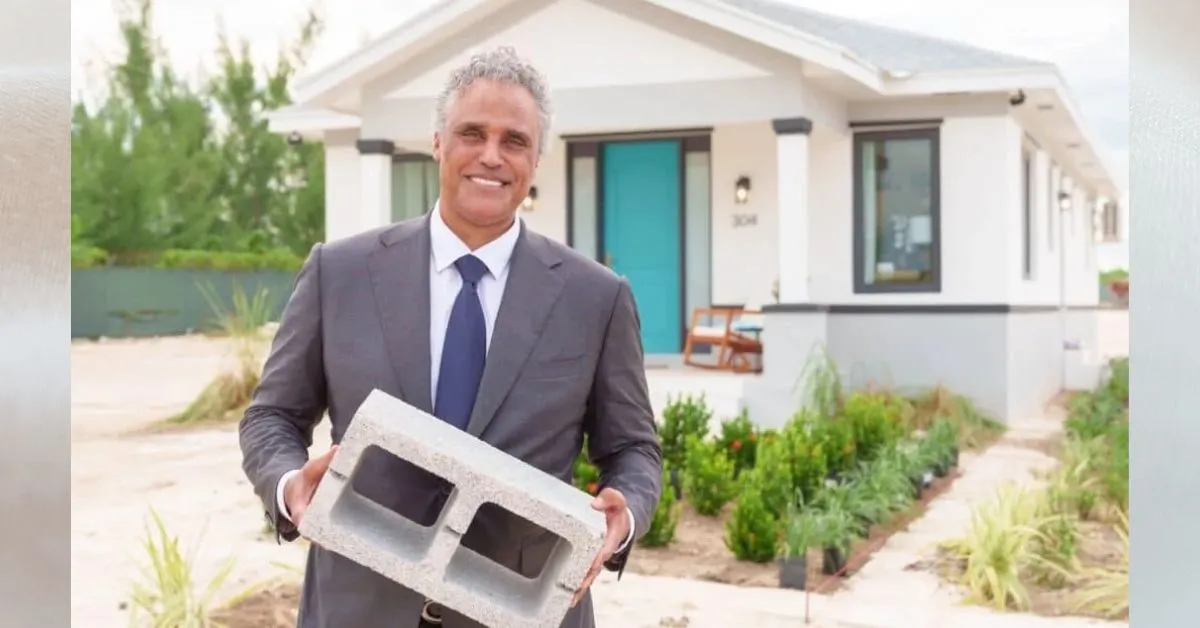Rick Fox, the former NBA Lakers legend turned actor, is currently working on a project in the Bahamas to build eco friendly homes using an alternative concrete technology that captures carbon dioxide from the atmosphere. He is the CEO and co-founder of the sustainable building materials startup Partanna, which aims to construct 1,000 homes like this in the Bahamas. The project is designed to combat climate change by offering a green building initiative that reduces pollution from construction.

Rick Fox made a significant career shift, leaving his Hollywood career behind to focus on creating climate solutions. He is now engaged in sustainable building materials and working on projects to combat climate change. Despite encountering skepticism from those in the industry unfamiliar with his concrete project, Fox is determined to make a positive impact in the fight against climate change.
Cement production, a key component of concrete, contributes significantly to global carbon dioxide emissions. This environmental impact has prompted a push to develop more sustainable and eco-friendly construction materials to reduce emissions associated with the construction industry. Rick Fox’s startup, Partanna, is working on alternative concrete technology to help mitigate the carbon footprint of construction. By creating eco-friendly building materials, they aim to reduce the negative environmental effects of concrete production.
Rick Fox’s involvement in the world of concrete and sustainable construction materials was driven by a desire to innovate and create solutions for his home country, the Bahamas. In the wake of Hurricane Dorian’s devastation in 2019, which severely affected the Bahamas, particularly the island of Abaco, he felt compelled to take action. The hurricane’s impact on the housing infrastructure and the displacement of thousands of people motivated him to find better, more resilient solutions for building homes.
Rick Fox’s journey into sustainable construction materials and alternative concrete began after Hurricane Dorian struck the Bahamas in 2019, causing widespread destruction. It was a wake-up call that inspired him to take action and find innovative solutions to build more resilient homes and communities, particularly in regions vulnerable to climate change and extreme weather events.
ALSO READ: IEA’s Updated Climate Roadmap: Prioritizing Proven Renewable Solutions for Urgent Climate Action
Rick Fox met architect Sam Marshall, who had previously developed a method for making concrete without relying on carbon-intensive cement. Together, with the help of material scientists, they co-founded Partanna, a startup focused on creating sustainable building materials and addressing the environmental impact of traditional concrete production.
While the exact details of the alternative concrete formulation developed by Partanna are not fully disclosed, it is known to incorporate brine from desalination plants and slag, a byproduct of steel production. The key innovation is the elimination of traditional cement, which is a major source of carbon dioxide emissions during concrete production. Cement production involves heating raw materials to high temperatures in a kiln, leading to CO2 emissions. Additionally, a chemical reaction with limestone releases more CO2. By removing cement from the equation, Partanna’s alternative concrete significantly reduces its carbon footprint.
Partanna’s alternative concrete offers several environmental advantages. It can cure at ambient temperatures, reducing the energy required for the curing process. The binder ingredients in the mixture have the capability to absorb CO2 from the atmosphere and trap it within the material. In structures made from this material, it continues to absorb CO2, contributing to carbon sequestration. Even if the structure is demolished, the material retains the trapped CO2 and can be reused as an aggregate to produce more of the alternative concrete, creating a closed-loop system that helps combat climate change.
Partanna refers to its material and the newly constructed home as carbon negative because the material has the capacity to capture more CO2 than it emits, making it environmentally beneficial. The 1,250-square-foot home is estimated to have sequestered as much CO2 as approximately 5,200 mature trees would in a year.
The carbon offset system has faced some challenges, as it can be complex and difficult to verify. In some cases, carbon offsets may not lead to actual pollution reductions. Partanna is working with Verra, a leading carbon credit certifier, to certify its carbon credits. Fox believes that quantifying the CO2 captured by Partanna’s material is more straightforward and less vulnerable to issues like deforestation, which can affect carbon storage in forests.
Partanna’s key ingredients, slag and brine, are sourced from energy-intensive steel and desalination facilities, both of which can produce substantial CO2 emissions during their operations. Partanna has not included these emissions in its carbon footprint calculations, emphasizing that they are using waste materials for positive purposes. While repurposing waste materials is a positive step, it is essential to conduct a comprehensive analysis of the entire environmental impact, according to Dwarak Ravikumar. He suggests that Partanna should provide data for researchers to evaluate the overall environmental footprint of its approach and assess its scalability.
Partanna is not the only entity striving to create more sustainable building materials as alternatives to traditional concrete. Companies like Microsoft are also exploring carbon capturing concrete technology for their data centers, and numerous startups are developing methods to capture CO2 from the atmosphere and sequester it within concrete materials.
Partanna highlights its competitive advantage, which lies in the use of brine as a key ingredient. Additionally, the material is designed to become stronger when exposed to seawater, a particularly desirable feature for a nation composed of numerous low-lying islands that face increased risks from severe storms and rising sea levels.
The government of the Bahamas is actively collaborating with Partanna to construct 1,000 homes, with the initial phase focusing on a community comprising 29 additional houses scheduled for completion by the following year. While the first prototype home in Nassau is currently unoccupied, the subsequent homes are anticipated to be part of an initiative aimed at assisting first-time homeowners.









